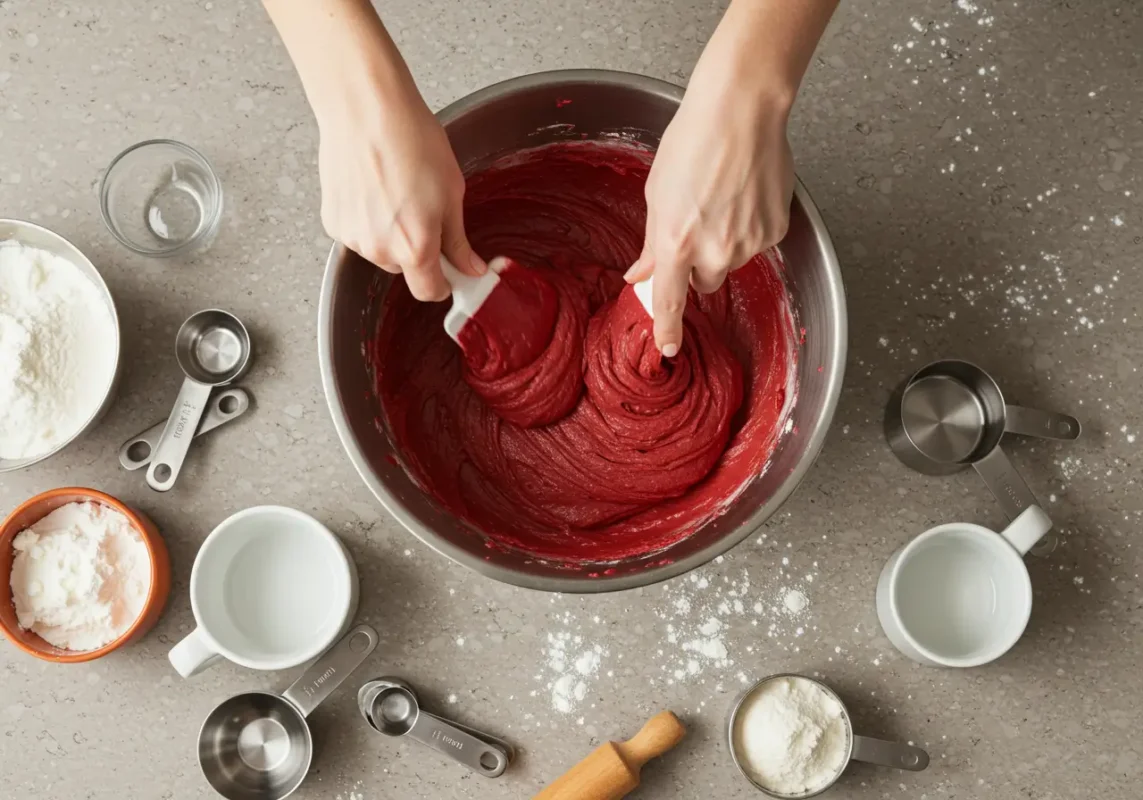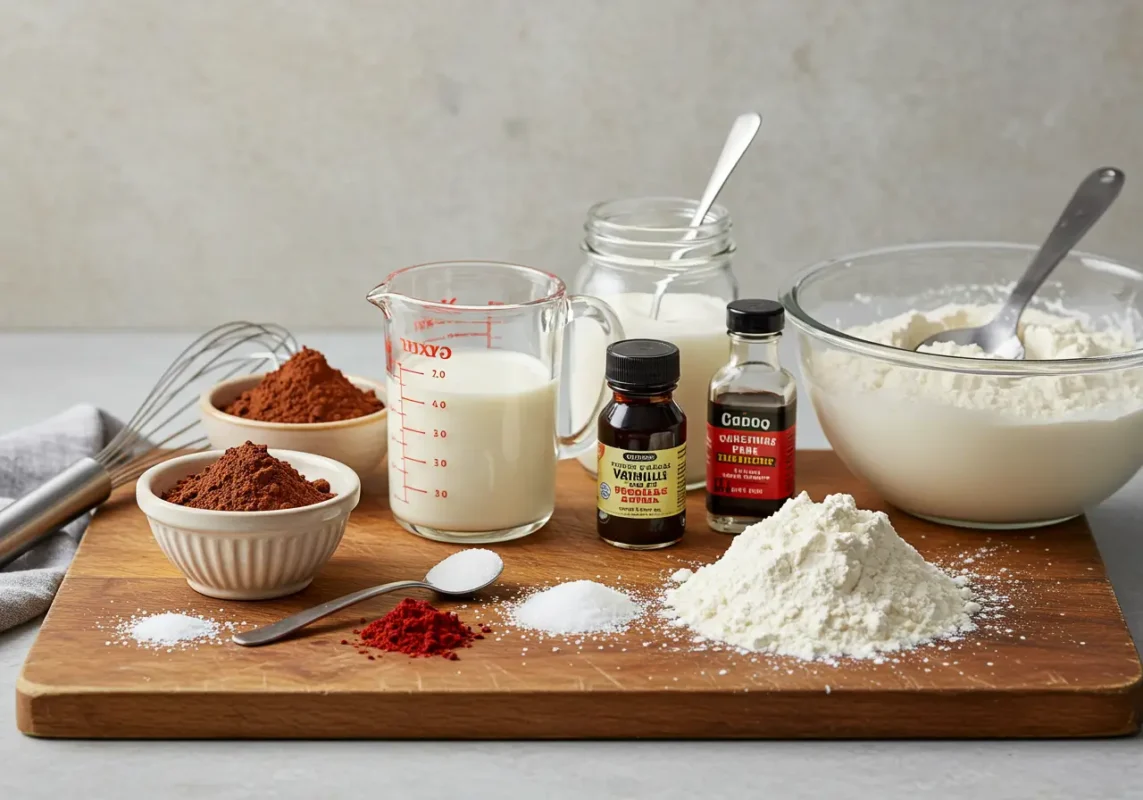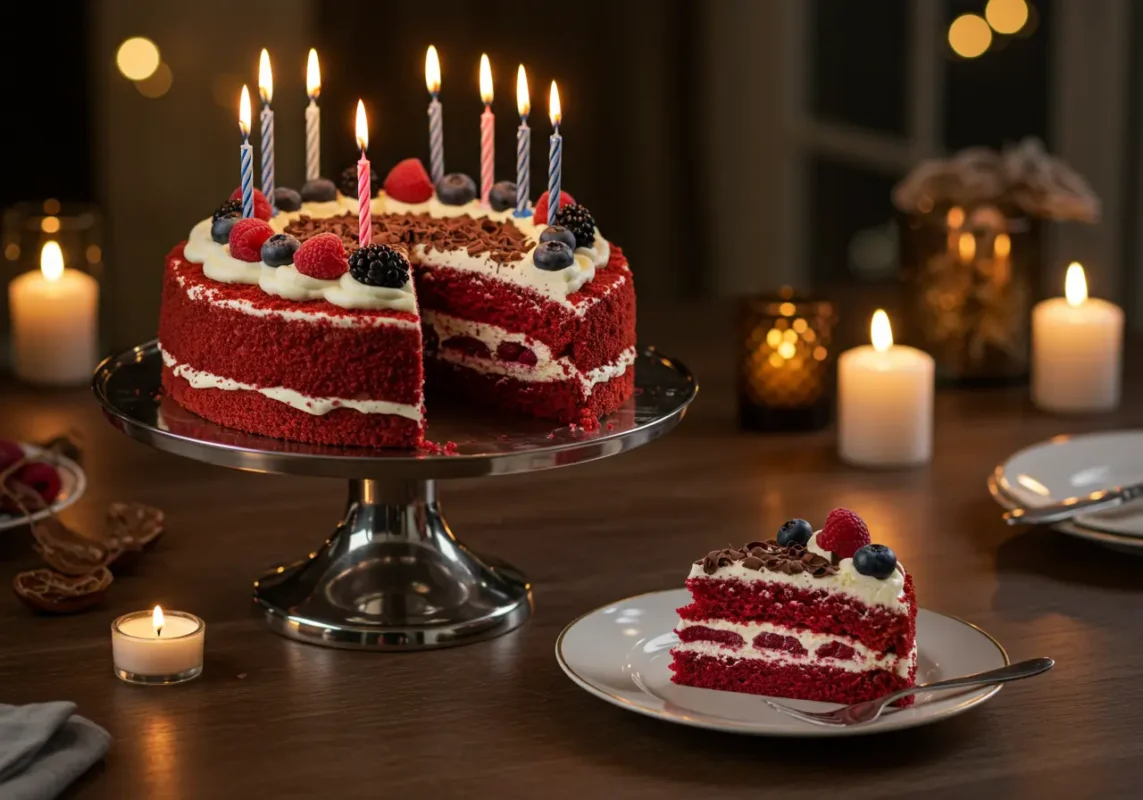What Makes Red Velvet Taste Better? Unveiling the Secrets Behind the Perfect Slice
Red velvet cake is more than just a dessert—it’s an experience. Its rich, velvety texture and distinctive flavor have made it a favorite among bakers and dessert enthusiasts. But what exactly makes this iconic cake so irresistible? In this article, we’ll dive deep into the science, techniques, and ingredients that answer the question: what makes red velvet taste better? From understanding the role of key ingredients like cocoa powder and buttermilk to mastering baking techniques, we’ll uncover the secrets behind crafting the perfect slice. Let’s get started!
Understanding the Basics of Red Velvet Flavor

What Makes Red Velvet Taste Better? Exploring the Core Ingredients
When baking, the right ingredients are the foundation of success. For red velvet cake, certain components play a critical role in creating its signature flavor and texture. Let’s break down the essentials.
The Role of Cocoa Powder in Enhancing Flavor
Cocoa powder is one of the unsung heroes of red velvet cake. It not only adds depth to the flavor profile but also contributes to the cake’s dark, reddish hue. However, not all cocoa powders are created equal. Natural cocoa powder, unlike Dutch-processed cocoa, tends to work best for red velvet because of its acidity. This acidity reacts with other ingredients, such as vinegar or buttermilk, to create a tender crumb and enhance the overall taste. For more insights into the differences between cocoa types, check out our guide on how to choose the right cocoa powder for your baking needs.
Why Natural Cocoa is Preferred Over Dutch Processed Cocoa
Natural cocoa has a slightly bitter edge that complements the sweetness of sugar in red velvet recipes. On the other hand, Dutch-processed cocoa is neutralized, which can dull the flavor nuances. By choosing natural cocoa, you ensure a richer, more complex taste that elevates your cake. For more insights into the differences between cocoa types, check out our guide on how to choose the right cocoa powder for your baking needs.
How Cocoa Contributes to the Richness and Depth of Flavor
Cocoa powder doesn’t just add chocolatey notes; it also balances out the sweetness. A well-balanced recipe ensures that no single ingredient overpowers the others, resulting in a harmonious blend of flavors.
The Importance of Sugar Balance in Red Velvet Cakes
Sugar is another crucial element in determining how good your red velvet cake tastes. While it’s tempting to load up on sugar for maximum sweetness, too much can mask the subtleties of other ingredients. Achieving the right balance is key to answering the question of what makes red velvet taste better.
Achieving the Right Sweetness Level Without Overpowering Other Flavors
Start by measuring your sugar carefully. Many professional bakers recommend using granulated white sugar for consistency. Still, some adventurous cooks might experiment with brown sugar for added molasses undertones. Regardless of your choice, remember that moderation is key. Too much sugar can make the cake cloyingly sweet, while too little can leave it bland. If you’re looking to refine your sugar selection, explore our tips on perfecting sugar ratios in desserts .
Focusing on these core ingredients will already get you well on your way to crafting a red velvet masterpiece. In the next part, we’ll explore the fascinating chemistry behind the cake’s unique flavor. Stay tuned!
What Chemical Reactions Make Red Velvet Taste Better?
What Chemical Reactions Make Red Velvet Taste Better?
The magic of red velvet lies not just in its ingredients but also in the chemistry that happens when they come together. Understanding these reactions can help you unlock the secrets to a truly delicious cake.
Buttermilk and Vinegar: A Dynamic Duo for Texture and Flavor
Buttermilk and vinegar might seem like odd additions to a cake, but their role is crucial. These acidic ingredients create the tender crumb that defines red velvet. Combined with baking soda, they produce carbon dioxide gas, which helps the cake rise beautifully. This reaction is one of the reasons why what makes red velvet taste better often boils down to the right balance of acidity.
How Acidic Ingredients React with Cocoa to Create a Tender Crumb
The acid from buttermilk and vinegar interacts with cocoa powder, enhancing its natural flavors while giving the cake its signature reddish tint. Without this interaction, the cake would lack both color and depth of flavor. It’s fascinating how something as simple as an acid-base reaction can transform ordinary ingredients into something extraordinary.
The Impact of These Ingredients on the Overall Taste Profile
In addition to texture, buttermilk adds a subtle tanginess that balances out the sweetness of sugar. This tang complements the rich cocoa notes, making every bite more satisfying. By incorporating these elements thoughtfully, you’re addressing what makes red velvet taste better.
The Science of Color and Its Influence on Perception of Flavor
Color plays a significant role in how we perceive food. For red velvet, the vibrant red hue isn’t just visually appealing—it also influences our expectation of flavor. While some recipes rely on natural pigments created by the cocoa-acid reaction, others incorporate food coloring for a brighter shade.
Does the Vibrant Red Color Affect How We Perceive the Cake’s Taste?
Studies suggest that people associate certain colors with specific tastes. A bright red cake might be perceived as sweeter or more indulgent than a duller version. So, even though the actual taste doesn’t change, the visual appeal enhances the overall experience. This highlights yet another factor contributing to what makes red velvet taste better.
Techniques That Answer What Makes Red Velvet Taste Better
Techniques That Answer What Makes Red Velvet Taste Better
Mastering the techniques involved in baking red velvet is just as important as selecting the right ingredients. Proper mixing, timing, and baking methods all contribute to achieving the ideal texture and flavor.
Perfecting the Mixing Process for Optimal Texture and Flavor
Mixing may seem straightforward, but it’s where many bakers go wrong. Overmixing can lead to a dense cake, while undermixing might result in an uneven distribution of ingredients. Striking the right balance ensures a light, airy crumb—a hallmark of great red velvet.
Tips for Mixing Ingredients to Avoid Overmixing and Ensure Even Distribution
Start by sifting dry ingredients like flour and cocoa powder. This step removes lumps and aerates the mixture, setting the stage for a smooth batter. Gradually incorporate wet ingredients, such as buttermilk and oil, mixing only until everything is just combined. Remember, less is more when it comes to mixing! For detailed instructions on proper mixing techniques, refer to our article on baking techniques for beginners .
The Importance of Not Overbaking the Cake
Overbaking is another common pitfall. Even a few extra minutes in the oven can dry out your cake, ruining its moistness. To avoid this, use a toothpick test—insert it into the center of the cake; if it comes out clean with a few crumbs attached, your cake is ready.
Experimenting with Additional Flavors to Enhance Taste
While traditional recipes are tried and true, there’s always room for creativity. Adding extracts like vanilla or almond can introduce new dimensions to the flavor profile. Alternatively, experimenting with alternative sweeteners, such as honey or maple syrup, can yield unique results.
Incorporating Vanilla or Almond Extracts for Extra Dimension
Vanilla extract is a classic choice because it enhances the cocoa’s richness without overpowering it. Almond extract, on the other hand, offers a nutty twist that pairs surprisingly well with the cake’s mild chocolate notes. These small adjustments can take your red velvet from good to great.
Considering Alternative Sweeteners for a Unique Twist
For those looking to shake things up, swapping part of the sugar for honey or maple syrup can add complexity to the flavor. These alternatives bring warmth and depth, answering what makes red velvet taste better in unexpected ways.
Learn more about using natural sweeteners in baking by reading our comprehensive guide on alternative sweeteners .
Selecting Ingredients That Make Red Velvet Taste Better

Selecting Ingredients That Make Red Velvet Taste Better
Choosing the right ingredients is a crucial step in baking red velvet cake. Each component plays a role in determining the final texture and flavor, so selecting high-quality options can significantly enhance your results.
Evaluating Different Types of Flour for Best Results
Flour forms the backbone of any cake recipe, and its type affects structure and texture. For red velvet, all-purpose flour is commonly used because it strikes a good balance between strength and tenderness. However, some bakers prefer cake flour for an even lighter crumb.
Comparing All-Purpose Flour with Cake Flour for Texture
Cake flour has a lower protein content than all-purpose flour, which creates less gluten when mixed. This results in a softer, more delicate cake. If you’re wondering what makes red velvet taste better, switching to cake flour could be worth trying. On the flip side, all-purpose flour provides a slightly firmer texture that holds up well under heavy frostings.
The Potential Use of Gluten-Free Alternatives
For those avoiding gluten, excellent gluten-free flours are now available. These blends mimic the properties of traditional wheat-based flours, allowing everyone to enjoy red velvet without compromising on taste or texture.
Selecting High-Quality Oils and Butters for Enhanced Moisture
Moisture is key to achieving a tender red velvet cake. Whether you choose oil or butter depends largely on personal preference and the effect you want to achieve.
Vegetable Oil vs. Butter: Which One Yields a Superior Product?
Vegetable oil keeps the cake moist and light, making it a popular recipe choice. Meanwhile, butter adds richness and depth of flavor. Some bakers combine the two to get the best of both worlds. When deciding what makes red velvet taste better, consider experimenting with different fats to see what works best.
What Makes Red Velvet Taste Better When Paired with the Right Frosting?
What Makes Red Velvet Taste Better When Paired with the Right Frosting?
Frosting isn’t just decoration—it’s an integral part of the red velvet experience. The right pairing can elevate your cake from good to unforgettable.
Classic Cream Cheese Frosting: A Timeless Choice
Cream cheese frosting remains the go-to option for most red velvet enthusiasts. Its tangy flavor complements the cake’s sweetness perfectly, creating a delightful contrast.
Customizing Cream Cheese Frosting for Personal Preference
You can tweak the basic cream cheese frosting recipe to suit your tastes. Adding a pinch of cinnamon or swapping powdered sugar for brown sugar can introduce subtle variations that make your cake stand out. Remember, customizing your frosting allows you to tailor the answer to what makes red velvet taste better based on your own palate.
Balancing Sweetness Between Cake and Frosting
It’s essential to strike a balance between the sweetness of the cake and the tanginess of the frosting. Too much sugar in either component can overpower the other, leaving the overall flavor flat. Adjust ratios carefully to ensure harmony.
Creative Alternatives to Traditional Frostings
While cream cheese frosting reigns supreme, there are plenty of alternatives worth exploring.
Exploring Whipped Cream or Ganache as Luxurious Options
Whipped cream offers a light, airy finish that contrasts beautifully with the dense cake layers. Ganache, on the other hand, brings decadence and richness. Both options provide unique ways to explore what makes red velvet taste better. If you’re feeling adventurous, try layering these frostings together for added complexity.

FAQs
Can I substitute buttermilk with regular milk in a red velvet recipe?
Yes, you can substitute buttermilk with regular milk, but it’s important to acidify the milk first. To do this, add 1 tablespoon of lemon juice or white vinegar to 1 cup of regular milk and let it sit for about 10 minutes. This creates a similar acidic environment that helps activate baking soda and enhances the cake’s texture. While whole milk works well as a substitute, buttermilk or an acidified version is recommended for optimal flavor and moisture.
Is it necessary to use food coloring in red velvet cakes?
No, food coloring isn’t strictly necessary. Traditionally, the reddish hue came from the reaction between cocoa and acidic ingredients like buttermilk or vinegar. However, modern recipes often rely on food coloring to achieve the vibrant red color associated with red velvet cakes. Without it, the cake may taste great but appear less striking visually.
What are some common mistakes people make when baking red velvet cake?
Overmixing the batter, overbaking, and incorrectly measuring ingredients are frequent errors. Another mistake is skipping the step of acidifying milk substitutes, which affects leavening and texture. Additionally, neglecting to balance sweetness with tangy elements (like cream cheese frosting) can lead to a cloyingly sweet result.
Conclusion
In summary, crafting the perfect red velvet cake involves understanding its key components and techniques. From selecting high-quality ingredients like natural cocoa powder and buttermilk to mastering mixing methods and baking times, every step answers what makes red velvet taste better. Acidic ingredients such as buttermilk or vinegar are critical in creating a tender crumb and rich flavor profile. In contrast, thoughtful experimentation with flavors and textures ensures uniqueness.
By paying attention to details—from ingredient selection to presentation—you can elevate your red velvet experience. Whether sticking to classic recipes or exploring creative twists, remember that practice makes perfect. So roll up your sleeves, preheat that oven, and enjoy the journey of baking one of the world’s most beloved desserts!






